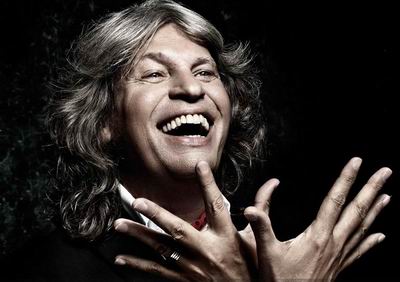|
The album opens in a deep and spectacular way with Balkan Martinete,adapted by José Mercé and with the voices remembering the east Europe. An original and shocking beginning with the voice of José Mercé who give way to Bulería del Morao,composed by Alejandro Sanz (who makes the chorus) and Diego del Morao (guitar), Layth Al-Rubaye (violin) and Piraña (Percussion). Dedicated to Moraíto Chico (“El barrio de Santiago está fuera de compás,las sillas estaban vacías y ya no hay soniquete por bulerías” sings Mercé). This album is a diamond with the singer on the top of his musical career, the wonderful Morao’s guitar and the violin with oriental reminiscences.
The single Si tú no estás is launched by alegrías with Manuel Parrilla (guitar) and Sandra Carrasco (voice) in a deep and beauty theme song whereas De ida y vuelta has tangos reminiscences with Diego del Morao (guitar, bouzouki) and in Bulería de pañuelo, Tomatito plays the guitar at the beginning.The wonderful treatment of the chorus and percussions (clappings included) are present during all the album.
Como aquel barquito is a musical adaptation by José Mercé, a soleá with Diego Morao as guitar-player. The album hasn’t got additions altering one of the basic palos of the flamenco.The tango sound is present during the song La llave del amor. The guitar-player is the same in almost all the album and the percussionist Piraña is present during all the album. After this song immediatly comes La Salvaora,the zambra composed by Quintero, León and Quiroga who popularized Caracol and which Mercé sing just accompanied by the pianist Alain Mallet,teacher of Berklee School of Music and who has played with Phil Woods,Paul Simon, Paquito D’Rivera and Madeleine Peiroux, he has also produced to Jonatha Brooke. Mallet and Mercé offers a new point of view in one of the most achieved flamenco-jazz fussion examples.
Bulería de Oriente takes up again Diego el Morao and Piraña and Elegía a Ramón Sijé de Miguel Hernández is a composition of Enrique Morente with Pepe Habichuela as guitar-player and Eric Truffaz as trompetist. Considered as one of the greatest musicians of the European Jazz,the French Erik Truffaz mix in his albums jazz,rock,hip-hop,world music and electronic. He is defined as “The pope of the electro-jazz” and his contribution to the José Mercés’s music begins a new music way,accompanied by Pepe Habichuela , veteran Patriarca (Patriarch) in mix flamenco with other kind of musics.The album ends with the song Eso es mentira a different tangos with del Morao as guitar-player and Mi única llave,fandango with Layth Al-Rubaye for close again the circle with oriental reminiscences.
Mi única llave is the new album featured by José Mercé, ne of the main phenomenos of the flamenco art. With many sold Cd’s in the last 15 years, he singer is an artist who has knew to transmit that the flamenco is for all the people as well as he knew how to transmit the flamenco to everybody without missing deepness and essence. osé Mercé represents the real,true and deep flamenco taked to the general public, specially since 1998 when he published the album Del amanecer which is according to the flamenco expert José Manuel Gamboa “this album converted to José Mercé in a multitude artist”
With 17 published albums since his debut in 1968, José Mercé has kept the pure essence of the singing and he mixed with flamenco versions by Manu Chao,Luis Eduardo Aute,Víctor Jara, Louis Amstrong, Pablo Milanés, the Pop Tops and Joan Manuel Serrat. This collaborations besides of his single songs placed to Mercé as one of the main musicians of the Spanish music, breaking the rules and bringing his songs not only to the flamenco public,also to the young pop public.
José Soto Soto (José Mercé) is the great-grandson of Paco Luz and nephew of Manuel Soto “Sordera”, patriarca of the flamenco from Jerez. When José Mercé was a child he starded to sing in the Escolanía de la Basílica de La Merced (he took his artistic name from this school) after the school he started his professional career in Los Jueves Flamencos de Jerez and in the gaditano tablao La Cueva del Pájaro Azul. At the age of 13 he arrived to Madrid( “I earned 500 pesetas per day” he says)for recording his first CD produced by Manuel Ríos Ruiz. He was in the company of Antonio Gades, he participated in 1981 in the film Bodas de Sangre by Carlos Saura, he has also collaborated at National Ballet, he won the National Flamenco Art Competition in 1986…and so on
José Mercé debuted in 1968 with the album Cultura jonda 14. Bandera de Andalucía. After few years he worked in important jobs like Verde Junco (1983) with Tomatito and Enrique Melchol, Caminos Reales del Cante (1987) , Hondas raíces (1991) and Desnudando el alma (1994). In 1998 was his jump to the popularity with the album Del amanecer produced by the guitar-player Vicente Amigo, reaching an unprecedented success then the album Aire (2000) reached an important success too “Is an album made from the bottom of the heart” say José Mercé. After came Confí de fuá (2004), Grandes éxitos ( 2003 ) and Ruido (2010). In February 2010 Mercé got the medal of Andalucía, honorable mention that recognize the merits of the singer.
|









































 Wholesalers/Stockists
Wholesalers/Stockists Contact
Contact





